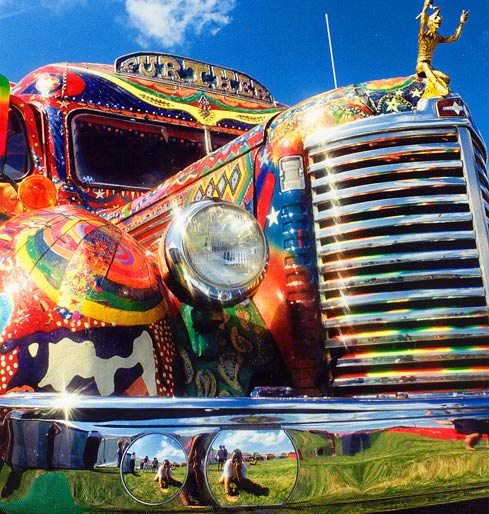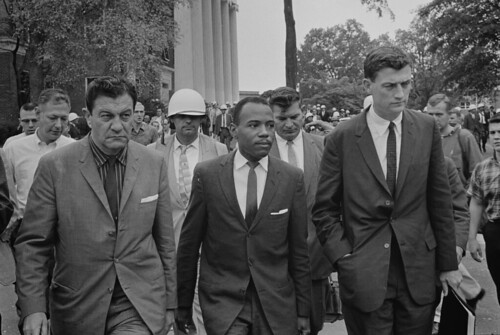MERRY PRANKSTERS & A STREETCAR NAMED DESIRE

The sound of the steelbelts eating asphalt beneath the behemoth Greyhound Scenicruiser. The countryside gliding by gently and quietly as the swaying motion of the bus gently rocks you to sleep. Whoops...there goes Nebraska. Wyoming. New Mexico. North Carolina. The Atlantic and the Pacific Coast. The bus pushes ever onward, confident in it's pursuit of the next stop...confident, because, this my friends, is the royal realm of The Greyhound Bus!!!
See America First...Leave the Driving to Us!! You meet the nicest people on a Greyhound!! Greyhound has been a part of Roadhead lore and legend since it's conception in 1914. It has also become the object of downright derision and outright hostility, as well as out and out adoration and recommendation for sainthood among the bus faithful.
Bus travel itself was pretty well summed up in Steve Earle's "Continental Trailway Blues", and buses have taken thier rightful place in the Roadhead Gallery of Transportation, from the proletarian Greyhound to the psychedelic bus of Ken Kesey and the Merry Pranksters as they flew over the cuckoo's nest and rolled merrily along America's social highway in the tie-dyed Sixties. In this Roadhead journey we'll buckle up and visit the Greyhound Bus Museum in Minnesota, where it all began, then put on some Grateful Dead and journey with Ken Kesey and Neal Cassidy on the bus called "Further" as it travels from San Francisco to New York City and ...well..further! Ever wonder whatever happened to the Partridge Family Bus? We'll c'mon let's all get happy and groovy as the Partridge Family takes a break at a Mexican restuarant. The Rosa Parks bus takes a front seat at the Henry Ford Museum, and yes, there really is a streetcar named "Desire". So roll up for the magical mystery tour and find out who really does ride the magic bus as we hop aboard and get ready to kick asphalt!!

THE GREYHOUND MUSEUM
Hibbing, Minnesota, packed like a snowball in the great white north of the land of 10,000 lakes may seem unlikely as the birthplace of an American transportation icon. Snowshoes, maybe, but then again, Minnesota is the same state that also gave us the-times-they-are-a-changin' Bob Dylan and America's favorite meat in a can and pop culture legend, SPAM! Locked deep in the Mesabi Range, the region was home to mining and in particular, Swedish miners, who in the early part of the 20th century found that getting to and from the mines and traveling between the towns of Hibbing and Alice were not exactly a leisurely walk in the iron ore park. One who noticed that there had to be a solution to this problem to help ease the strain was Carl Wickman, a miner himself. He didn't have to be a rocket scientist to figure out that if the miners had reliable transportation to and from the towns, at a reasonable cost, he could not only give his neighbors a helping hand, but also be a good capitalist, and thereby a good American citizen, by making a little spare change in the process. It didn't take a rocket scientist to figure it out, and Carl certainly not one, but he could do the math, and it all added up to profits.
In 1914, Carl modified a Hupmobile that could normally accomodate 5 to 7 people, and by the time his mechanical magic act was finished it would seat 15!! He then instituted a system of regular schedules for the 2 mile journey between the two towns that just happened to coincide with the miners schedules, and for a mere .15 cents one way or .25 cents round trip, the first route and fare was in place for what would eventually become known internationally as the Greyhound Bus Company...or simply, The Hound.
In time, the Hupmobiles were replaced by Americas industrial might as the manufacture of actual buses began, and Carl Wickman's two mile route would soon explode into a network of destinations that would carry Americans across the continent for business and pleasure, as well as in times of national emergency, world war and America's battle for Civil Rights.
The race to pave the planet and cover the continent in concrete was off and running as improved roads were being added to the transportaion fabric of the nation. As more roads were added, more vehicles were produced, and they rolled off the assembly lines with an insatiable appetite for even more roads. It was a Catch-22..or which came first scenario, the chicken or the egg. It was the asphalt and concrete version of the internet, connecting city after city and bus companies were popping up like daisies, but The 'Hound was the still the big dog on the block. Short hops and regional routes were the norm, but finally in 1927 Greyhound had completed it's first transcontinental route between New York and California. East meets West...Pacific meets Atlantic...Coast to Coaset..and they did it in 5 and a half days. It was the Transcontinental Railroad Golden Spike of it's day!!
The Greyhound marched on and went further and further, making it necessary for regular stops where the driver and the passengers could re-fuel themselves with food and drink. The route was littered with a patch quilt network of eateries without standardization of food quality or service, so needless to say complaints were common and numerous. To offset the possible loss of ridership and revunue that poor quality food and service might result in, Greyhound, in 1940, set up a network of restaurants in their terminals that would offer standardized fare to their paying passengers. These were appropriately named "Post House Restaurants", and featured the famous Stagecoach logo on the dishes. Greyhound and America had now come to terms with one another and could finally relax in each others company, at least until 1941
WWII broke out like a plague and Americans mobilized for the war effort. The troops had to be carried to various training camps across the land of democracy, and Greyhound was there and went into the troop transport business like a well oiled war machine. The war ultimately ended in victory for the Allies, and times boomed in the victorious postwar United States. Jobs were plentiful and returning GI's had some money...money enough to buy some of those Detroit dream machines with big shiny grills and fins. As car sales went up, Greyhound ridership decreased and the company became the asphalt Conestoga of the proletariat...but once again Greyhound would be called on to enter the transportation fray.
Segregation battled integration in the sixites, and while southern city buslines were still relagating backseat ridership based on skin color, Greyhound was helping aid the Civil Rights movement by hauling whole armies of Freedom Riders into the social battleground of deep rooted southern fried racism. Bus lines have come and gone....the bankruptcy courts have take their toll and still...Greyhound remains. Not the silver glory hound of yore, but a legend nonetheless and you can visit it's remains at the Greyhound Museum in Hibbing, Minnesota.
That's right the mobile backseat crosscountry party bus company has it's own museum as tribute to the silver beast. Appropriately located on East Greyhound Blvd. in Hibbing, Minnesota, it's open to the public, including the curious who've never actually traveled aboard one, as well as actual Greyhound Vets who've walked the dog and journeyed the 'Hound from coast to coast. The admission is cheap too...three or so bucks for adults and you enter the world of the Scenicruiser!!
'Hound history comes alive through a series of interpretive displays, collections of memorabilia and a video explaining the "History of Greyhound". The gift shop, as can be expected is fully loaded with Greyhound caps, t-shirts, cups and mugs, spoons, books and movies and my fave, model Greyhound buses!! London Tower may have it's prized crown jewells but at the Greyhound Museum they have the diamonds of diesel world in the form of actual Greyhound buses including the 1914 Hupmobile to a 1948 Silverside and the classic 1956 Scenicruiser. Add in a festival called Bus Bash and a tour to Bob Dylan's boyhood home and you have a weekend in Hibbing, Minnesota. Greyhound bus may take the front seat when it comes to mass transportation icons, but, lot to long ago, many Americans where forced to take a back seat due to the color of their skin.

THE ROSA PARKS BUS
The south of the sixties conjurs up visions of meanspirited town sherrifs, german shepard dogs on the attack and firehoses turned on crowds to disperse them. Chicken hearted hooded freaks burning down churches and setting crosses ablaze in the night while hiding under hoods and sheets. Signs at public places proclaiming "Whites Only"...."No Coloreds" The National Guard walking students into schools and Freedom Riders and Civil Rights workers being gunned down and beaten to death. The fires had always been smoldering but ignited in a firestorm of rebellion by one lone woman on a city bus in Montgomery, Alabama in 1955.

It was still a time when the first 10 front seats were reserved for white passengers only. Beyond those seats it was expected that black passengers would give up their seats to white passengers if demanded. One day on the Cleveland Ave bus it was demanded. The lone black woman, Rosa Parks refused and was consequently arrested. This was the opening salvo of the civil rights shot heard round the world. A young minister named Martin Luther King, Jr. took up the cause and led the cities black population in a bus boycott that lasted a year and finally in 1956 bus segregation was ruled illegal by the US Supreme Court.
The times may have finally changed, but what about that bus? It was a 36 passenger diesel with hydraulic transmission that was manufactured in Pontiac, Michigan in 1948. It first saw service in Terra Haute, Indiana until 1954 and then was purchased by the Montgomery bus company and ran from 1954 until it's retirement in 1971. It was sold as surplus to Roy Summerford in 1971 and took it's place, rusting and rotting, forgotten in a field for 30 years until 2001, when it was purchased at auction by the Henry Ford Musuem in Dearborn, Michigan.
In that time the windows had been smashed, the engine gone, rust and weather taking it's toll on the old girl. Restoration bids were taken and cost of $300,00 was partially offset by a Federal grant of $205,000 designated for a fund to protect America's treasures. The Rosa Parks bus is certainly that, a true American treasure and a monument to a voice that defied the odds and in the end defeated an army of hate.